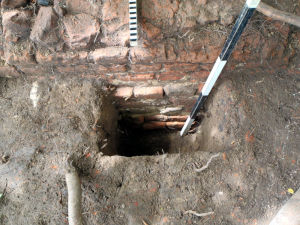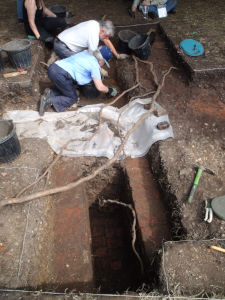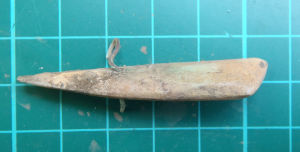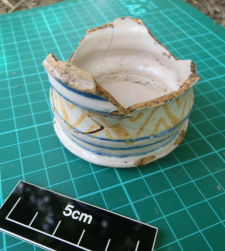01 Jun 2018
Forty Hall Spring Dig - Day 5

We made the most of the improved weather today and continued to make great progress in our two main trenches exploring the 16th century 'long barn' building and nearby drain.
In trench one we have now exposed the south wall of the building which has survived, at various depths, for the whole length of the trench, except for one spot where a 19th century land drain has been cut through it.
The wall has turned out to be much more sturdy than had first appeared. After opening a small preview slot (pictured) in front of the wall, we found five further courses of foundations including two offsets, making nine surviving courses in all. Given the length of the barn and the weight of a peg-tile roof, this is not so surprising!

We also got on well in trench two, where we began excavating the extension we laid out late yesterday, which aims to locate the point where the north-south wall of the barn's west end meets the substantial palace drain we exposed the top of yesterday.
We found the top of the north-south wall and, as anticipated, found it turns 90 degres, to form the barn's north side. Though we haven't fully uncovered the drain at this point yet, it looks like it will probably follow this north side of the barn very closely (though it may have to make a change in direction to do so).
The only complication is the heavily damaged remains of yet another, previously unrecorded wall between the two, which may predate them both, but interpreting this won't be possibly until the area is fully excavated.
In the section of drain we exposed yesterday, we began removing the fill to it's full depth of 11 courses, finding, as last year, its brick base.
So far, also in common with last year, we're finding that the fill of the drain is predominantly rubble, and there's no obvious sign of an original silt from when the drain was in use.
Tomorrow we plan to take some bulk samples of the fill for environmental analysis, which may tell us more.

The fill has not been devoid of finds, though; in fact some very interesting things have already come from it, including a piece of apparently shaped bone - perhaps a boar's tusk - pierced with a small copper wire, which we think is maybe a toggle fastener or perhaps a small pendant -- a nice personal object. There's also been plenty of pottery, quite a bit of bone and window glass and even some of the leads that would have held it.

Perhaps the best find of the day though, was an almost complete Delft 'drug jar' -- a squat tin-glazed earthenware pot dating to the mid seventeenth century -- towards the end of the palace's occupation.
As the name suggests, Delftware was originally made and imported from Holland, though potters eventually set up business in London, attempting (usually not very well!) to imitate Chinese porcelain. We've also had a few small fragments of decorated Delft tiles from across the site.
Late in the day today we opened probably the last trench of the dig, targeting the north side of the barn building, aiming to take in some of the wall that we're now sure runs parallel to the wall in trench one, and to also get another look at the floor surface within the barn, which we have not yet been able to see much of, especially in an undisturbed state.
The forecast still looks pretty good for the weekend, so hopefully we should get plenty of visitors.